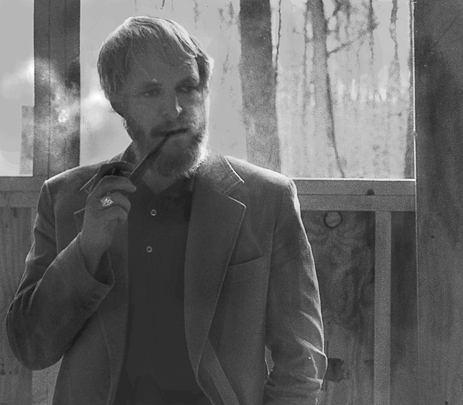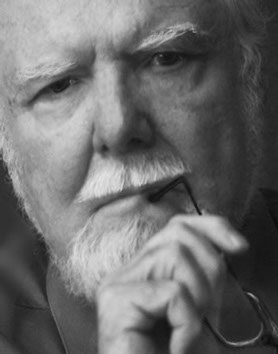

That’s my friend Jim Harrell, AIA, in 1980 or thereabouts, standing inside our house under construction in an Ohio woods, taking another puff from his pipe, and giving me another “I see that as….” I had engaged Jim as our architect in charge of specifications, meeting building code requirements, and drawing the final blueprints, but not for design, which I, an MD and not an AIA, would arrogate unto myself, totally. Or so I thought.**
Somehow, without my quite realizing it, behind his smoke screen soft-speaking Jim got a lot of his own design ideas into the final design. “I see the roof line as being 30°,” he murmured. I had declared it would be 15°. It wound up 30°. How did he do that? After trying to figure it out for the last thirty years I’ve concluded that it was his smoky incantation, “I see…as,” that did it. His ideas were worthwhile; his “I see…as,” invaluable, worth his fee, a bit of cubicle wisdom Dilbert’s pointy-haired manager has not yet apprehended. Regardless of the organization chart, the guy most often murmuring “I see …as” has the last word. I tried like the dickens to emulate both Jim’s “seeing as” and his professional, robot-perfect architectural lettering, succeeding with the former far better than the latter.
But Jim’s vision of the roofline didn’t turn out to be the most enduring of his seeings-as. "I see this house as never finished," he bowed his head and murmured when I presented him with my 18th version of the front elevation. Plumb right, that vision! For as long as we lived there, 25 years, greenhouses and patios and decks and fences were added or remodeled. I’d still be at it if we hadn’t moved out and sold the place, leaving it to new owners and their architect who, according to rumor, sees it as…
All architects talk like Jim. It must be taught in architecture school, like architectural lettering.
So do we pathologists. At the microscope, eyes fixed upon a slide, pathologists can be heard murmuring, “I see this as an epithelioma of Malherbe” while another is saying, “But I see it as Bushski-Lowenstein.” But it's hard to smoke a pipe and look down a microscope at the same time.
Among architects, Frank Lloyd Wright is said to have started it. But I’ll bet it goes back to the lead architect of the Tower of Babel project, who proclaimed, “I see this tower as reaching unto and into the heavens.” In any case, ever since F.L. Wright, like the brothers Wright, took off from the flatlands and flew into his wild blue architectural yonder, architects have been seeing themselves as philosophical astronauts striving for orbits far out, farther out, simultaneously reaching for the heavens and for the masses. No longer merely draftsmen, they see themselves as seers.
I see such reaching for both the heavens and the masses as sounding exactly like politicians (or the same politician at different times). “I see America as the greatest dream and hope of all mankind.” “I see America as a nightmare and as owing apologies to all mankind.” “I see the only way to get our economy going and to cut our stifling debt is to raise taxes.” “I see the only way to …. is to lower taxes.”
Which I see as right off the drafting tables and out of the wind pipes of philosophers. I see philosophy huffing and puffing Modernism into Postmodernism, in nearly the same breath of pipe smoke.
Born of the Enlightenment philosophers such as Voltaire in the 18th century, Modernism was not so much a rejection of authority as the replacement of divine supremacy by the human, especially pipe-puffing humans. The philosophical replacing the priestly. God and the Bible were replaced by, to use the Wikidemic vocabulary, “master normatives,”notably science, the darling of Modernism, and Evolution, the firstborn of Modernist science. Modernist absolutism also spawned the Master Race, Nazism and Eurocentricity, Capitalism and Marxism, all at least as absolute and arbitrary as the divine, and more oppressive and abominable, and even more dreary and astringent, serious and sober.
So from the smoke of WWII’s flaming absolutism, Derrida and ilk puffed Modernism out and inhaled Postmodernism, which rejects all authority and all absolutes, including truth, and everything accruing therefrom, including and especially morality. Instead of truth, trends; instead of eternal morality, ethics, gone up in smoke at the next seminar or court session. Nothing is eternal, all is fumes. Nothing is absolute, all is relative. Relative to itself, not to any standard. Nothing is good for more than a day. Tomorrow morning something new. I see Postmodernism as never finished. The only stable foundation is whimsy. So if Modernism and its transmogrified authority was all sobriety, Postmodernism and its vapor is all whimsy, that’s its trademark, the only part of it I like.
As I see it, among the whimsical things Postmodernism does – it’s just the start -- is to reject and decapitate Capitalism as arbitrary while exalting and empowering Marxism, the most relativistic and totalitarian system of government yet. That cracks me up.
How Postmodernism handles Marxism is sane compared to how it whacks science and, consequently, Evolution. Under Modernism’s absolutism science was seen as the master against which all else was to be judged, and Evolution is science’s legitimate scion. But Postmodernism comes along and with one puff blows away absolutism and standards of any kind. Thus science is zapped, thus evolution. Then it wheels around and issues metamedia communiqués whimsically insisting that under its administration the science sector, especially its new darling, Global Warming, is doing fine, having been granted waivers.
Like the indulgence for the medieval Church, the waiver is turning out to be the happy instrument of postmodernism, especially Marxist government, starting with healthcare. If everything is relative in theory, everything can be waivered in practice, without a whimper, just a wink. Eternal morality and the prePostmodernist Constitution are inconveniently immovable. Were.
If male and female made He them, Postmodernism waives even genders. I’m so old I remember when the French -- French poets, French peasants, all us peasants, if not French philosophers -- once exclaimed in ecstasy and dances, perfume and hairdos, in song and Hallmark card, “Vive la différence.” But Postmodernism annuls, with all gravitas and not a trace of whimsy, in court if not in bed, any such difference, and to contend otherwise is a hate crime, punishable by law which suddenly is conveniently immutable and unwaivable. Waiving God, just a spirit by His own statement, is a snap and of less consequence compared to waiving the genders, with their different chromosomes, hormones, receptor sites, total anatomy, total physiology, total metabolism, total mystery, just as a start. But waive goodbye to all that. I’m so old I remember when I could never understand women. Now I can’t understand Postmodernism not understanding women.
But God made us male and female, at least He said so, and proceeded to join male and female, and what God hath joined together let no man put asunder. Ha! A big Postmodernist ha!
But seriously, folks, Postmodernism is truly, in fact, and honestly the ultimate utopian formula for literature and philosophy and religion. Literary philosophy and philosophical literature, especially epistemology, even religion, seem to have been waiting throughout all human history for deliverance by Postmodernism, not by the Messiah old religion had always claimed to yearn for. From that old Messiah enlightened religion was now liberated, and by Postmodern religion laughed off and waived.
Postmodernist religion’s relativistic revelation does miracles through hermeneutics. For literature and philosophy what works like a charm is deconstructionism.
Deconstructionism? To architecture in its drafting and engineering mode, that's an oxymoron. T-squares, plumb lines, laser levels and yardsticks, and forests of rebar and tons of superhard concrete and solid foundations, all must be unwavering and the construction codes not waived. As to who gets the construction contract, waiver upon waiver may come rolling in, but hold the construction standards.
But in it’s pipe-puffing seeing-as mode, architecture disappears into its cloud of Modernist and Postmodernist philosophy and politics and manifestos, like it or not. I don’t. I see both Modernist and Postmodernist architecture as only design styles, ways of handling masses or forms, arches and colonnades, filigree or fretwork or the lack of it. I see artistic principles, not politics. I like those.
At this point gentle Jim, though a puff of pipe smoke, could be inserting, “I see this as all very interesting and I wouldn't want to interrupt, but it's not getting us any closer to deciding on the roof line. But don’t let that stop you. I charge by the hour, you know.”
When I – and Jim – designed our house in Ohio years ago, before Postmodernism, my wife and I went to Chicago, which, like Bauhaus in Germany, was one of the birthplaces of Modernist architecture. We took the Architectural Tour. The tour guide explained that, artistically speaking (the tour was too short for him to get around to the politics, for which Chicago is even more famous), Modern means simplicity, make that Simplicity with a capital S, which means reduction or even elimination of detail, whether realistic or simply decorative, down to the quintessential skeletal essences: form, motion, value, color, down to honesty. The early twentieth century had a thing about honesty. Hemingway was the Honesty poster boy. The more improbable his fiction, the more “honest,”he said.
Under Postmodernism, simplicity was to go from Bauhaus box to digital wriggle. Honesty, as Honest Abe or even Honest Ernest saw it, never had anything to do with it, unless a Gropius cube and a Phillip Johnson all-glass house are more honest than a Gehry unremittingly metal-clad three-dimensional Bézier chaos. Maybe they are. At any rate, you don’t hear about “honesty” much any more (except in quotes), which is, well, honest, because under Postmodernism there isn’t any such thing. Now, in this era of the Postmodernist TSA, metal detectors, whole body scanners, and TV attack ads, it’s “Transparency.” Meaning, one-way glass, as in Presidential teleprompters and promises.
all-glass house are more honest than a Gehry unremittingly metal-clad three-dimensional Bézier chaos. Maybe they are. At any rate, you don’t hear about “honesty” much any more (except in quotes), which is, well, honest, because under Postmodernism there isn’t any such thing. Now, in this era of the Postmodernist TSA, metal detectors, whole body scanners, and TV attack ads, it’s “Transparency.” Meaning, one-way glass, as in Presidential teleprompters and promises.
In any case, for “seeing as” to be properly and magisterially mouthed, that mouth must be toying with something besides words. A pipe is the prop, or was before Postmodernism in its whimsical obsession with rejecting the trappings of Capitalism and Western culture from neckties to pipes. I still wear neckties. But never smoked anything. I see eyeglasses dawdled in the mouth as a better prop for a seer.
Now then, after all this seeing-as, would you like to see how the house actually turned out? Click here.
This is basically an essay on Modernism and Postmodernism whimsically seen as architecture, sex, all the rest.